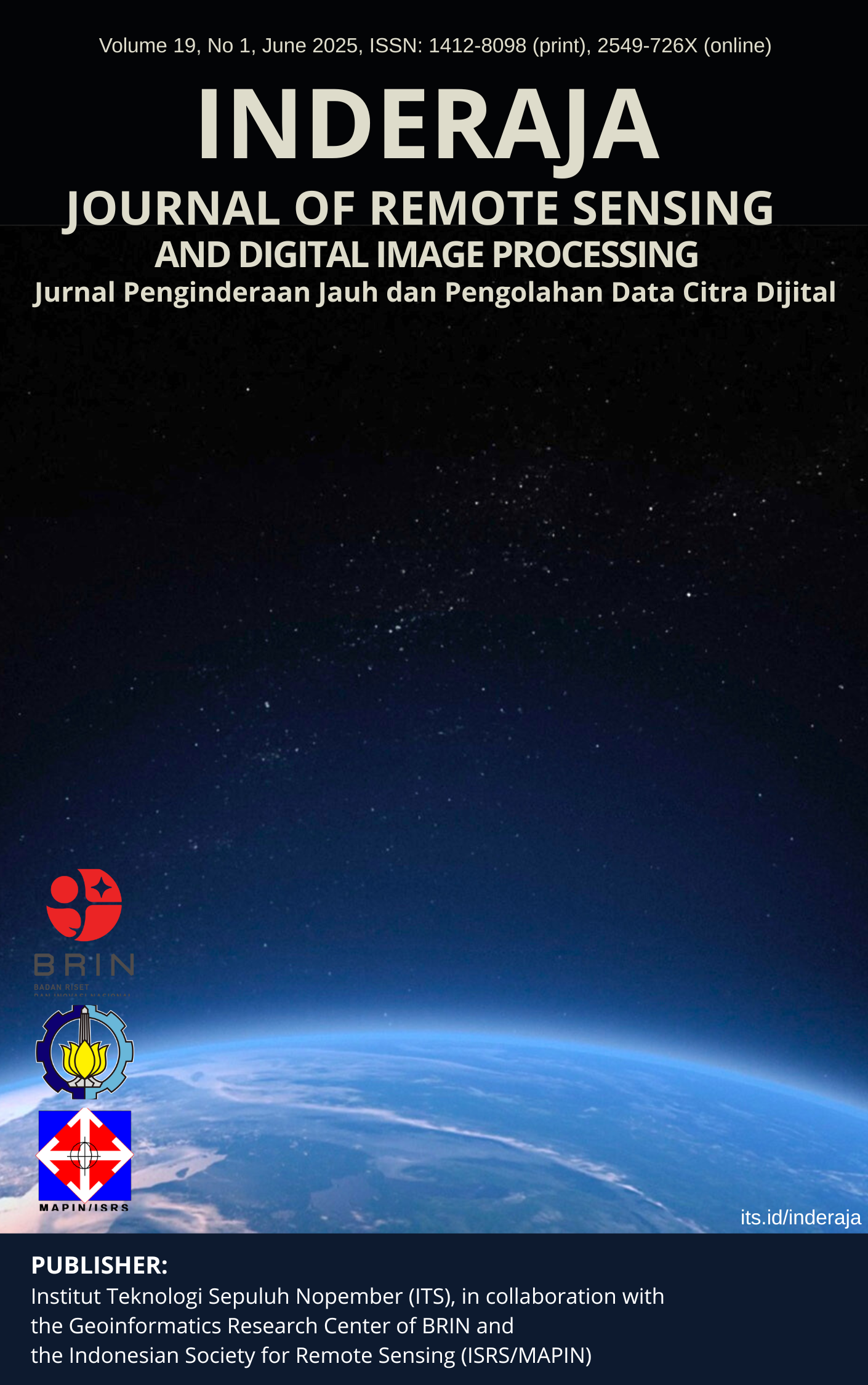Effectiveness of Normalized Difference Built-Up Index in Mapping Built-Up Features across Arid Rural Regions
Main Article Content
Abstract
Normalized Difference Built-up Index (NDBI) is a widely used remote sensing method for detecting built-up areas. However, its effectiveness in distinguishing built-up land from open land in dry rural regions remains underexplored. This study aims to evaluate the performance of NDBI in identifying built-up areas in Bayat Sub-district, Klaten Regency, Central Java, a predominantly rural area with semi-arid land characteristics during October 2023. The analysis employed Landsat 8 OLI imagery acquired in 2023, which was processed to generate NDBI values. These values were classified into four built-up intensity levels using the natural breaks (Jenks) method: Very Low, Low, Medium, and High. Validation was conducted using 36 ground truth points representing land cover types such as vegetation, built-up land, open land, and water bodies. Classification accuracy was assessed through a confusion matrix. The results revealed a significant degree of misclassification. NDBI is computed from the difference in reflectance between the Shortwave Infrared (SWIR) and Near Infrared (NIR) bands, where built-up areas typically exhibit high SWIR and low NIR values. However, dry open land (e.g., bare soil or unvegetated areas) displays a similar spectral pattern, high SWIR reflectance due to dry surfaces, and low NIR reflectance from the absence of biomass. This similarity causes elevated NDBI values for dry open areas, making them difficult to distinguish from actual built-up regions. The confusion matrix yielded an overall accuracy of 75.00% and a Kappa coefficient of 0.628, indicating moderate agreement between the classification results and ground data. These findings highlight the limitations of NDBI in differentiating built-up land from non-vegetated open land in semi-arid rural settings.
Downloads
Article Details

This work is licensed under a Creative Commons Attribution-NonCommercial-ShareAlike 4.0 International License.
References
Badan Pusat Statistik Kabupaten Klaten, Kecamatan Bayat dalam Angka 2024, 2024.
Bappeda Klaten, Rencana Tata Ruang Wilayah Kabupaten Klaten Tahun 2022–2042, 2022. [Online]. Available: https://bappeda.klatenkab.go.id
BMKG, Data Iklim Kabupaten Klaten Tahun 2023, 2023. [Online]. Available: https://iklim.bmkg.go.id
R. G. Congalton and K. Green, Assessing the Accuracy of Remotely Sensed Data: Principles and Practices, 2nd ed. Boca Raton, FL: CRC Press, 2009.
M. D. Jamil, P. Danoedoro, and Hartono, “Kajian kerentanan kekeringan wilayah Kabupaten Klaten menggunakan penginderaan jauh dan sistem informasi geografis,” Majalah Ilmiah Globe, vol. 15, no. 2, pp. 123–132, 2013.
J. R. Jensen, Introductory Digital Image Processing: A Remote Sensing Perspective, 3rd ed. Upper Saddle River, NJ: Pearson Prentice Hall, 2005.
Rasul et al., “Applying built-up and bare-soil indices from Landsat 8 to cities in dry climates,” Sensors, vol. 18, no. 2, p. 629, 2018, doi: 10.3390/s18020629.
Roy et al., “Landsat-8: Science and product vision for terrestrial global change research,” Remote Sensing of Environment, vol. 145, pp. 154–172, 2014, doi: 10.1016/j.rse.2014.02.001.
Shafira, F. Kristiani, and B. Yong, “Penerapan metode klasifikasi perangkat lunak ArcMap pada pemetaan penyebaran penyakit dengue di Bandung,” Jurnal Geografi dan Sistem Informasi, vol. 10, no. 2, pp. 101–110, 2022.
Wicaksono, M. S., & Darmawan, S. (2021). Pemetaan Dan Pemantauan Lahan Terbangun Perkotaan Dengan Data Landsat Multitemporal Menggunakan Google Earth Engine (Studi Kasus: Kota Bandung, Jawa Barat Dan Kota Semarang, Jawa Tengah). Prosiding FTSP Series, 395-400.
E. Suparta and A. Hartono, “Detecting urban sprawl using NDBI and NDVI in Surabaya from 2002–2022,” Journal of Remote Sensing Applications, vol. 6, no. 2, pp. 101–110, 2024.
J. R. Thomlinson, P. V. Bolstad, and W. B. Cohen, “Coordinating methodology for remote sensing-based change detection,” Remote Sensing of Environment, vol. 70, no. 1, pp. 66–77, 1999.
Y. Yasin, R. Ismail, and K. Jusoff, “Urban land use classification using integrated remote sensing and GIS techniques: Case study in Iskandar Malaysia,” Environmental Earth Sciences, vol. 81, no. 4, pp. 1–14, 2022.
J. Zha, J. Gao, and S. Ni, “Use of normalized difference built-up index in automatically mapping urban areas from TM imagery,” International Journal of Remote Sensing, vol. 24, no. 3, pp. 583–594, 2003.

